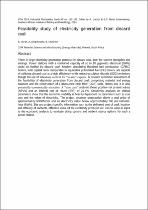JavaScript is disabled for your browser. Some features of this site may not work without it.
- ResearchSpace
- →
- Research Publications/Outputs
- →
- Journal Articles
- →
- View Item
| dc.contributor.author |
North, Brian C

|
|
| dc.contributor.author |
Engelbrecht, AD

|
|
| dc.contributor.author |
Oboirien, B

|
|
| dc.date.accessioned | 2015-12-18T12:28:21Z | |
| dc.date.available | 2015-12-18T12:28:21Z | |
| dc.date.issued | 2015-07 | |
| dc.identifier.citation | North, B.C, Engelbrecht, A.D and Oboirien, B. 2015. Feasibility study of electricity generation from discard coal. Journal of the SA Institute of Mining and Metallurgy, vol. 115, pp 153- 165 | en_US |
| dc.identifier.issn | 2225-6253 | |
| dc.identifier.uri | http://www.saimm.co.za/Journal/v115n07p573.pdf | |
| dc.identifier.uri | http://hdl.handle.net/10204/8319 | |
| dc.description | Copyright: 2015 SAIMM. Due to copyright restrictions, the attached PDF file only contains the abstract of the full text item. For access to the full text item, please consult the publisher's website. The definitive version of the work is published in Journal of the SA Institute of Mining and Metallurgy, vol. 115, pp 153-165 | en_US |
| dc.description.abstract | A techno-economic assessment was undertaken in two phases. The first is essentially a material and energy balance, in which fuel and sorbent requirements are calculated using input data such as plant size, plant efficiency, fuel CV, Ca/S ratios etc. Additionally, in this phase, operating costs, fuel and sorbent transport costs and revenue (from the sale of electricity) are calculated. The figures calculated in the first phase are then used to construct the second phase, a Discounted Cash Flow (DCF) analysis. This is used to run sensitivity analyses and to calculate economic indicators such as the Net Present Value (NPV) and the Internal Rate of Return (IRR). The “base case” showed positive NPVs and an IRR above the chosen hurdle rate of 20%. Sensitivity analyses where then conducted on the following parameters: a) Specific capital cost, b) Cost of coal, c) ransport distance for sorbent (plus consideration of specific sorbent sources), d) Electricity selling price, e)Electricity price increases over the life of the plant. Tis detailed economic analysis shows that a discard coal-fired Circulating Fluidized Bed Combustion (CFBC) power station could return an IRR of 22.6%. There are, however, many scenarios to be considered, many of which cause the IRR to fall below the adopted hurdle rate of 20%. Coal cost and electricity pricing were seen to have a large impact on the IRR. Site-specific information, such as the true cost of fuel, cost and transport cost of sorbent and the efficacy of the sorbent etc., can be used as input to the economic analysis to evaluate siting options and sorbent source options for such a power station. | en_US |
| dc.language.iso | en | en_US |
| dc.publisher | SAIMM | en_US |
| dc.relation.ispartofseries | Workflow;15884 | |
| dc.subject | Fluidised bed combustion | en_US |
| dc.subject | Discard coal | en_US |
| dc.subject | Techno-economic assessment | en_US |
| dc.subject | Net Present Value | en_US |
| dc.title | Feasibility study of electricity generation from discard coal | en_US |
| dc.type | Article | en_US |
| dc.identifier.apacitation | North, B. C., Engelbrecht, A., & Oboirien, B. (2015). Feasibility study of electricity generation from discard coal. http://hdl.handle.net/10204/8319 | en_ZA |
| dc.identifier.chicagocitation | North, Brian C, AD Engelbrecht, and B Oboirien "Feasibility study of electricity generation from discard coal." (2015) http://hdl.handle.net/10204/8319 | en_ZA |
| dc.identifier.vancouvercitation | North BC, Engelbrecht A, Oboirien B. Feasibility study of electricity generation from discard coal. 2015; http://hdl.handle.net/10204/8319. | en_ZA |
| dc.identifier.ris | TY - Article AU - North, Brian C AU - Engelbrecht, AD AU - Oboirien, B AB - A techno-economic assessment was undertaken in two phases. The first is essentially a material and energy balance, in which fuel and sorbent requirements are calculated using input data such as plant size, plant efficiency, fuel CV, Ca/S ratios etc. Additionally, in this phase, operating costs, fuel and sorbent transport costs and revenue (from the sale of electricity) are calculated. The figures calculated in the first phase are then used to construct the second phase, a Discounted Cash Flow (DCF) analysis. This is used to run sensitivity analyses and to calculate economic indicators such as the Net Present Value (NPV) and the Internal Rate of Return (IRR). The “base case” showed positive NPVs and an IRR above the chosen hurdle rate of 20%. Sensitivity analyses where then conducted on the following parameters: a) Specific capital cost, b) Cost of coal, c) ransport distance for sorbent (plus consideration of specific sorbent sources), d) Electricity selling price, e)Electricity price increases over the life of the plant. Tis detailed economic analysis shows that a discard coal-fired Circulating Fluidized Bed Combustion (CFBC) power station could return an IRR of 22.6%. There are, however, many scenarios to be considered, many of which cause the IRR to fall below the adopted hurdle rate of 20%. Coal cost and electricity pricing were seen to have a large impact on the IRR. Site-specific information, such as the true cost of fuel, cost and transport cost of sorbent and the efficacy of the sorbent etc., can be used as input to the economic analysis to evaluate siting options and sorbent source options for such a power station. DA - 2015-07 DB - ResearchSpace DP - CSIR KW - Fluidised bed combustion KW - Discard coal KW - Techno-economic assessment KW - Net Present Value LK - https://researchspace.csir.co.za PY - 2015 SM - 2225-6253 T1 - Feasibility study of electricity generation from discard coal TI - Feasibility study of electricity generation from discard coal UR - http://hdl.handle.net/10204/8319 ER - | en_ZA |






